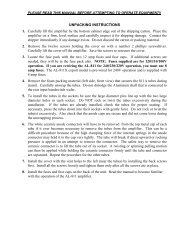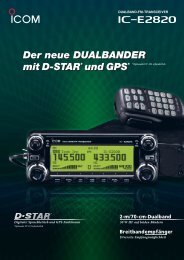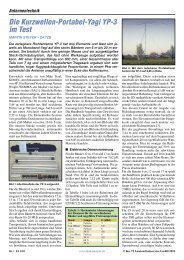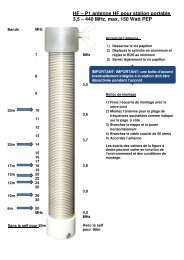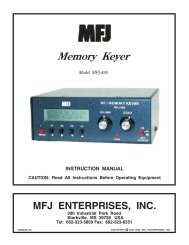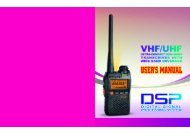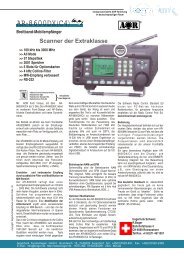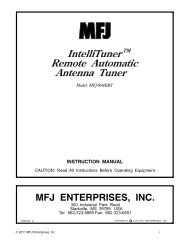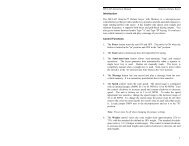MFJ-442 Keyer/Bencher Combo Manual - Thiecom
MFJ-442 Keyer/Bencher Combo Manual - Thiecom
MFJ-442 Keyer/Bencher Combo Manual - Thiecom
You also want an ePaper? Increase the reach of your titles
YUMPU automatically turns print PDFs into web optimized ePapers that Google loves.
<strong>MFJ</strong>-422D/422DX Instruction <strong>Manual</strong> Electronic <strong>Keyer</strong> Paddle<br />
Introduction<br />
The <strong>MFJ</strong>-422D Electronic <strong>Keyer</strong> Paddle is an iambic keyer and paddle<br />
combination. The <strong>MFJ</strong>-422DX keyer installs on your <strong>MFJ</strong>-564 or <strong>Bencher</strong> type<br />
paddle. Both are microprocessor controlled keyers that provide iambic key<br />
operation and dot-and-dash memory to make sending perfect code easier. It has<br />
tunable code speed, code weight, and sidetone frequency; it supports both direct<br />
and grid-block keying outputs. You also get to choose between Iambic Type<br />
"A" and Type "B" keying.<br />
Note: All references to the <strong>MFJ</strong>-422D apply to the <strong>MFJ</strong>-422DX, unless<br />
otherwise stated.<br />
Control Functions<br />
1. The Power button turns the unit ON and OFF. The power is ON when the<br />
button is locked in the "in" position and the LED is lit and OFF in the "out"<br />
position.<br />
2. The Semi-Auto/Auto button allows semi-automatic "bug" and manual<br />
operations. The keyer generates dots automatically when a squeeze or<br />
single lever key is used. Dashes are manually made. The keyer is<br />
completely manual when a straight key is used. Semi-Auto is active when<br />
the switch is in the "in" position and Auto when in the "out" position.<br />
3. The Speed control, located on the left side of the unit, varies the code speed.<br />
The speed range is configured with an internal jumper (JMP9) for 5 to 65<br />
WPM or 10 to 40 WPM. Turn the control clockwise to increase speed and<br />
counter-clockwise to decrease speed. The unit is factory set to 5 to 65<br />
WPM. To make the speed adjustment less sensitive, change the speed range<br />
to the narrower range of 10 to 40 WPM. To change the speed range the<br />
power must be off, then remove the paddle to access the jumper inside the<br />
case. Locate jumper JMP9 next to the microprocessor and set it to the "H"<br />
position.<br />
Note: Power must be off when changing the jumper settings.<br />
4. The Volume control, located on the left side of the unit, adjusts the sidetone<br />
level of the internal speaker. Turn the control clockwise to increase the<br />
volume and counter-clockwise to decrease the volume.<br />
5. The Weight control varies the code weight from approximately 25% to<br />
75%, with the standard dot defined as 50% weight. The standard dot-dash-<br />
1
<strong>MFJ</strong>-422/422DX Instruction <strong>Manual</strong> Electronic <strong>Keyer</strong> Paddle<br />
2<br />
space ratio is 1:3:1 (trimpot at mid-range). This control is accessed through<br />
a small hole on the rear of the unit and may be adjusted using a small flatheaded<br />
screwdriver. This control is turned clockwise to increase dot and<br />
dash lengths and counter-clockwise to decrease dot and dash lengths.<br />
6. The Tone control sets the desired sidetone pitch from approximately 300 to<br />
1200 Hz. This control is also accessed through a small hole on the rear of<br />
the unit and may be adjusted using a small flat-headed screwdriver. This<br />
control is turned clockwise to raise the pitch and counter-clockwise to lower<br />
the pitch.<br />
7. The Key Output circuit supports both positive and negative keyed radios.<br />
The <strong>MFJ</strong>-422D can only key one type of transmitter at a time. This is an<br />
internal jumper selected option. The unit is factory set to direct keying<br />
(most solid state radios). To change to grid-block keying (most radios with<br />
tube finals) the power must be off, then remove the paddle to access the<br />
jumpers inside the case. Locate jumpers JMP1 and JMP2. JMP2 is directly<br />
behind the RCA jack (J2). JMP1 is located behind the power jack (J1). Set<br />
both jumpers JMP1 and JMP2 to the "G" position. To key a solid state<br />
transmitter, set both jumpers to the "D" position.<br />
Note: Power must be off when changing the jumper settings.<br />
8. The Iambic Type A/B mode is also set inside the unit with a jumper. The<br />
unit is factory set for Type "A" Iambic. If you prefer Type "B" Iambic,<br />
remove the paddle to access the jumper. Locate jumper JMP3 behind the<br />
power jack (J1), between JMP1 and JMP8; set it to the "B" position. For<br />
Type "A" Iambic, set the jumper to the "A" position.<br />
Note: Power must be off when changing the jumper settings.<br />
When a squeeze is released during an element (dot or dash), type "B" adds<br />
the opposite element. Type "A" just finishes the element in progress and<br />
does not produce a following alternate element. For example, in Type "A"<br />
Iambic, a squeeze release during the "dah" in the letter A will produce "dit<br />
dah" (A). In Type "B" Iambic, a squeeze release during the "dah" in the<br />
letter A will produce "dit dah dit" (R).<br />
Paddle Installation for the <strong>MFJ</strong>-422DX
<strong>MFJ</strong>-422D/422DX Instruction <strong>Manual</strong> Electronic <strong>Keyer</strong> Paddle<br />
If you purchased the <strong>MFJ</strong>-422DX (keyer without paddle), you must install it<br />
onto your paddle. Follow these instructions for installing the <strong>MFJ</strong>-422DX onto<br />
a <strong>MFJ</strong>-564 or <strong>Bencher</strong> type paddle:<br />
1. Remove any cables from the paddle. Do not apply power to unit while it is<br />
disassembled.<br />
2. Set up your <strong>MFJ</strong>-422DX now, using the four internal jumpers, to the type of<br />
output keying required, the desired Iambic mode, and the speed range.<br />
Refer to items 3, 7 and 8 of the previous section for locations and meanings<br />
of these jumpers; also, refer to the “Jumper Settings” section on page 5 for<br />
the meanings of these jumpers.<br />
3. If you wish to use a nine volt battery, install one now. A nine volt battery<br />
fits in the battery clip located inside the case. <strong>MFJ</strong> suggests the use of a<br />
good long-life alkaline battery for longest operation.<br />
4. Remove the rubber foot from the bottom rear of the paddle.<br />
5. Remove the plastic cable clamp from the bottom center of the paddle.<br />
6. Slide the <strong>MFJ</strong>-422DX on to the back of the paddle. Thread the cable<br />
through the slot on the bottom of the <strong>MFJ</strong>-422DX. Secure the case with the<br />
rubber foot and new screws. The <strong>MFJ</strong>-564 Iambic Paddle has four<br />
additional holes to better secure the case of the paddle.<br />
7. Connect the BARE wire of the cable to the middle terminal on the bottom of<br />
the paddle for GROUND.<br />
8. If you normally operate the paddle right-handed, then connect the DOT<br />
(white or clear colored) wire to the left paddle terminal and the DASH<br />
(black) wire to the right terminal. Connect the wires the opposite way if you<br />
operate the paddle left-handed.<br />
9. Place the cable in the plastic cable clamp and secure it with a screw. Fold<br />
any excess cable up into the unit.<br />
Connections<br />
3
<strong>MFJ</strong>-422/422DX Instruction <strong>Manual</strong> Electronic <strong>Keyer</strong> Paddle<br />
1. A nine volt battery (not included) may be installed. Remove the case by<br />
removing the screws on the bottom that secure it to the paddle. A battery<br />
clip, located inside the case, is provided for installing a nine volt battery.<br />
2. A 12 Vdc power supply may also be used to power the <strong>MFJ</strong>-422D. A<br />
2.1mm coaxial plug with a positive center and a negative sleeve should be<br />
used to power this unit. The <strong>MFJ</strong>-1312B, an optional power adapter, is<br />
available from <strong>MFJ</strong> Enterprises, Inc. The battery is automatically<br />
disconnected when external power is used.<br />
3. The keying circuit allows keying of grid-block and solid state transmitters.<br />
Keying output connection is made with a quality standard shielded RCA<br />
cable between your radio key input and the <strong>MFJ</strong>-422D's Key Output jack.<br />
4<br />
Note: Consult the transmitter's instruction manual to determine which<br />
output to use. When in doubt, try both jumper positions. The<br />
transmitter will key continuously or not at all when the jumpers are<br />
connected to the wrong positions.<br />
<strong>Keyer</strong> Operation<br />
1. A nine volt battery or an optional power adapter may be used to supply<br />
power to the keyer.<br />
2. The keyer should be turned on by pressing the Power button and the LED is<br />
lit.<br />
3. The Semi-Auto/Auto button should be in the "out" position for automatic<br />
operation.<br />
4. The user should now start sending with the paddle and adjust volume, tone,<br />
weight, and speed to his or her preference.<br />
5. The dot and dash memories make sending easier. The memories allow the<br />
user to key a dot before the completion of a dash and vice versa. This<br />
feature can be checked by setting the keyer to the lowest speed and tapping<br />
first the dash lever and then the dot lever before the completion of the dash.<br />
The keyer will provide both the dash and the dot. The dash memory can be<br />
checked in a similar manner. The dot insertion feature allows the user to<br />
insert a dot by tapping the dot lever while holding the dash lever in. The<br />
dash insertion feature allows the user to insert a dash while holding the dot<br />
lever in. The Iambic operation feature allows sending of alternate dots and
<strong>MFJ</strong>-422D/422DX Instruction <strong>Manual</strong> Electronic <strong>Keyer</strong> Paddle<br />
dashes when both paddles are squeezed. The first paddle contacted will<br />
determine whether a dot or dash occurs first.<br />
6. The user may select either Iambic A or B according to his or her preference.<br />
Jumper Settings<br />
JMP1 JMP2 Keying Mode<br />
D D Direct *<br />
D G Invalid<br />
G D Invalid<br />
G G Grid Block<br />
* Factory defaults.<br />
JMP3 Iambic Mode<br />
A A *<br />
B B<br />
JMP9 Speed Range<br />
L 5 - 65 WPM *<br />
H 10 - 40 WPM<br />
5
<strong>MFJ</strong>-422/422DX Instruction <strong>Manual</strong> Electronic <strong>Keyer</strong> Paddle<br />
Morse Code Character Set 1<br />
A di-dah • − N dah-dit − •<br />
B dah-di-di-dit − • • • O dah-dah-dah − − −<br />
C dah-di-dah-dit − • − • P di-dah-dah-dit • − − •<br />
D dah-di-dit − • • Q dah-dah-di-dah − − • −<br />
E dit • R di-dah-dit • − •<br />
F di-di-dah-dit • • − • S di-di-dit • • •<br />
G dah-dah-dit − − • T dah −<br />
H di-di-di-dit • • • • U di-di-dah • • −<br />
I di-dit • • V di-di-di-dah • • • −<br />
J di-dah-dah-dah • − − − W di-dah-dah • − −<br />
K dah-di-dah − • − X dah-di-di-dah − • • −<br />
L di-dah-di-dit • − • • Y dah-di-dah-dah − • − −<br />
M dah-dah − − Z dah-dah-di-dit − − • •<br />
1 di-dah-dah-dah-dah • − − − − 6 dah-di-di-di-dit − • • • •<br />
2 di-di-dah-dah-dah • • − − − 7 dah-dah-di-di-dit − − • • •<br />
3 di-di-di-dah-dah • • • − − 8 dah-dah-dah-di-dit − − − • •<br />
4 di-di-di-di-dah • • • • − 9 dah-dah-dah-dah-dit − − − − •<br />
5 di-di-di-di-dit • • • • • 0 dah-dah-dah-dah-dah − − − − −<br />
Period [.] di-dah-di-dah-di-dah • − • − • − AAA<br />
Comma [,] dah-dah-di-di-dah-dah − − • • − − MIM<br />
Question Mark or Request for Repetition [?] di-di-dah-dah-di-dit • • − − • • IMI<br />
Fraction Bar or Slash Bar [/] dah-di-di-dah-dit − • • − • DN<br />
End of Message, Plus Sign, or Cross [+] di-dah-di-dah-dit • − • − • AR<br />
End of Work di-di-di-dah-di-dah • • • − • − SK<br />
Double Dash, Equal Sign, Pause, or Break [=] dah-di-di-di-dah − • • • − BT<br />
Semicolon [;] dah-di-dah-di-dah-dit − • − • − • KR<br />
Colon [:] dah-dah-dah-di-di-dit − − − • • • OS<br />
Apostrophe ['] di-dah-dah-dah-dah-dit • − − − − • WG<br />
Quotation Mark ["] di-dah-di-di-dah-dit • − • • − • AF<br />
Hyphen or Dash [-] dah-di-di-di-di-dah − • • • • − DU<br />
Underline [_] di-di-dah-dah-di-dah • • − − • − IQ<br />
Dollar Sign [$] di-di-di-dah-di-di-dah • • • − • • − SX<br />
Left Parenthesis or Go Only [(] dah-di-dah-dah-dit − • − − • KN<br />
Right Parenthesis [)] dah-di-dah-dah-di-dah − • − − • − KK<br />
Wait or Stand By di-dah-di-di-dit • − • • • AS<br />
Understood di-di-di-dah-dit • • • − • SN<br />
Starting Signal dah-di-dah-di-dah − • − • − KA<br />
Error di-di-di-di-di-di-di-dit • • • • • • • • HH<br />
Paragraph [] di-dah-di-dah-di-dit • − • − • • AL<br />
Invitation to Transmit or Go Ahead [K] dah-di-dah − • − K<br />
6
<strong>MFJ</strong>-422D/422DX Instruction <strong>Manual</strong> Electronic <strong>Keyer</strong> Paddle<br />
1. FCC test requirement consists the 26 letters, the 10 numerals, the period, the comma, the question mark, AR , SK, BT and<br />
fraction bar DN .<br />
Signals Used In Other Radio Services<br />
Interrogatory di-di-dah-di-dah • • − • − INT<br />
Emergency Silence di-di-di-di-dah-dah • • • • − − HM<br />
Executive Follows di-di-dah-di-di-dah • • − • • − IX<br />
Break-in Signal dah-dah-dah-dah-dah − − − − − TTTTT<br />
Emergency Signal di-di-di-dah-dah-dah-di-di-dit • • • − − − • • • SOS<br />
Relay of Distress dah-di-di-dah-di-di-dah-di-dit − • • − • • − • • DDD<br />
Technical Assistance<br />
If you have any problem with this unit first check the appropriate section of this<br />
manual. If the manual does not reference your problem or your problem is not<br />
solved by reading the manual you may call <strong>MFJ</strong> Technical Service at 662-323-<br />
0549 or the <strong>MFJ</strong> Factory at 662-323-5869. You will be best helped if you have<br />
your unit, manual and all information on your station handy so you can answer<br />
any questions the technicians may ask.<br />
You can also send questions by mail to <strong>MFJ</strong> Enterprises, Inc., 300 Industrial<br />
Park Road, Starkville, MS 39759; by Facsimile to 662-323-6551; or by email to<br />
techinfo@mfjenterprises.com. Send a complete description of your problem, an<br />
explanation of exactly how you are using your unit, and a complete description<br />
of your station.<br />
Notes<br />
7
<strong>MFJ</strong>-422/422DX Instruction <strong>Manual</strong> Electronic <strong>Keyer</strong> Paddle<br />
Schematic<br />
8



